Day 4 of a four day Autumn Tour in Norfolk today, our last day. It was a grey and misty start again, which turned into drizzly rain for about half an hour mid-morning. But after that, it brightened up and there were some sunny intervals in the afternoon.
With big high tides at the moment, we decided to drive over to Snettisham for the Wader Spectacular. It meant an early start, and it was only just starting to get light when we met in Wells. We were a bit later than planned by the time we got out onto the seawall and the tide was already in as far as the crossbank. There was a big RSPB event on to, with loads of people and cars parked on the seawall. We decided to head straight on down to Rotary hide.
We had just stopped to scan from the bank in front of the hide, when the waders started swirling. It was a bit misty out over the Wash and we couldn’t see what had spooked them, but we were treated to some great action as the flocks of Knot flew back and forth over the mud, pulling an ever changing variety of shapes.
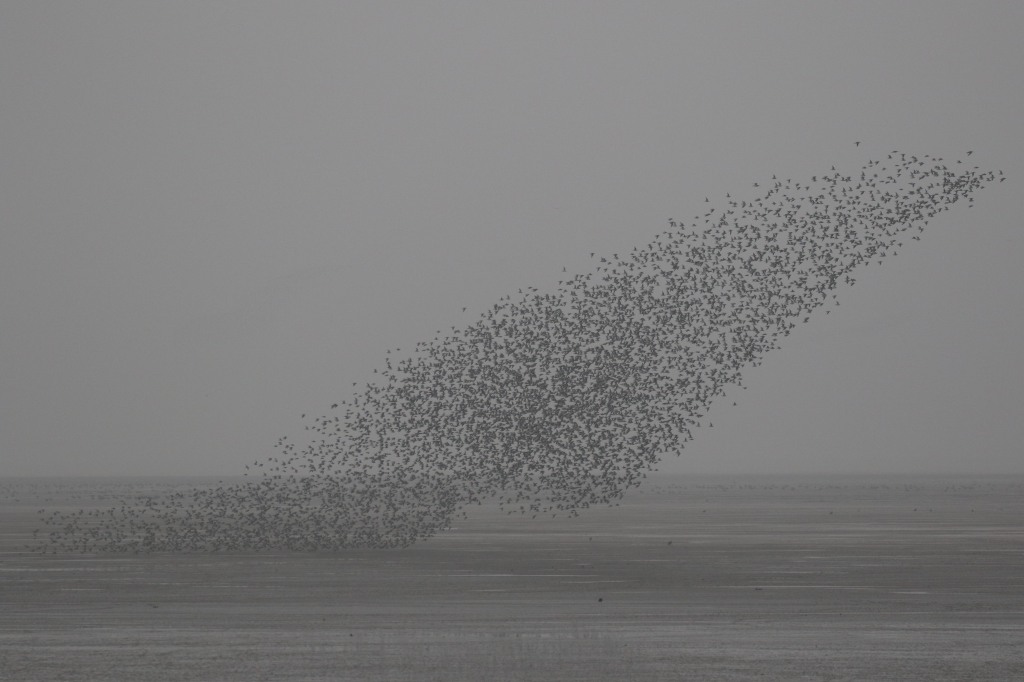
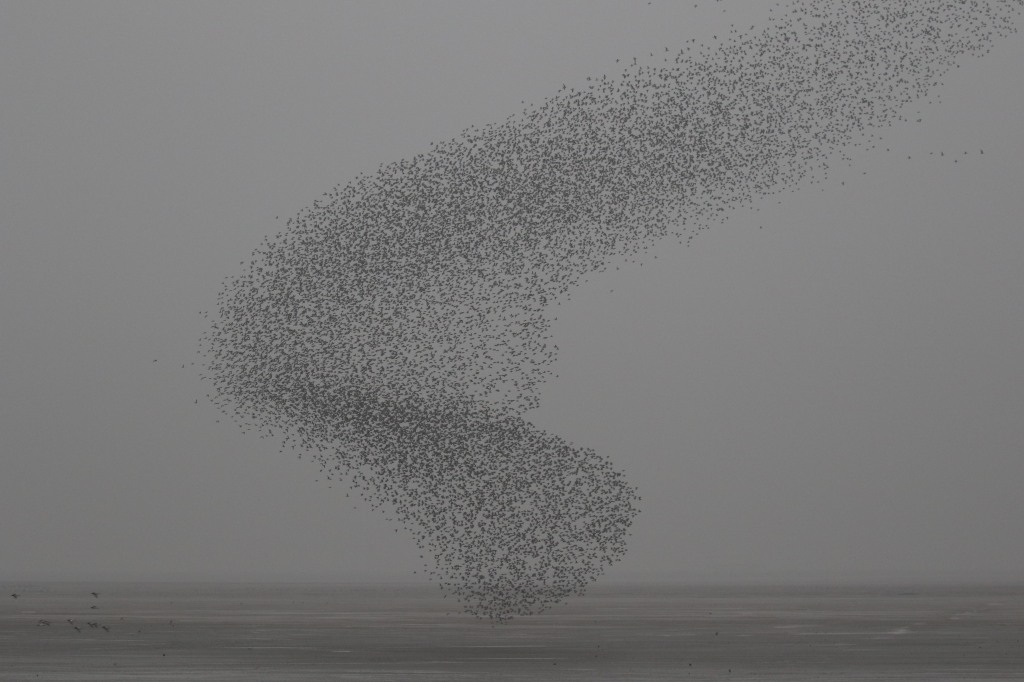
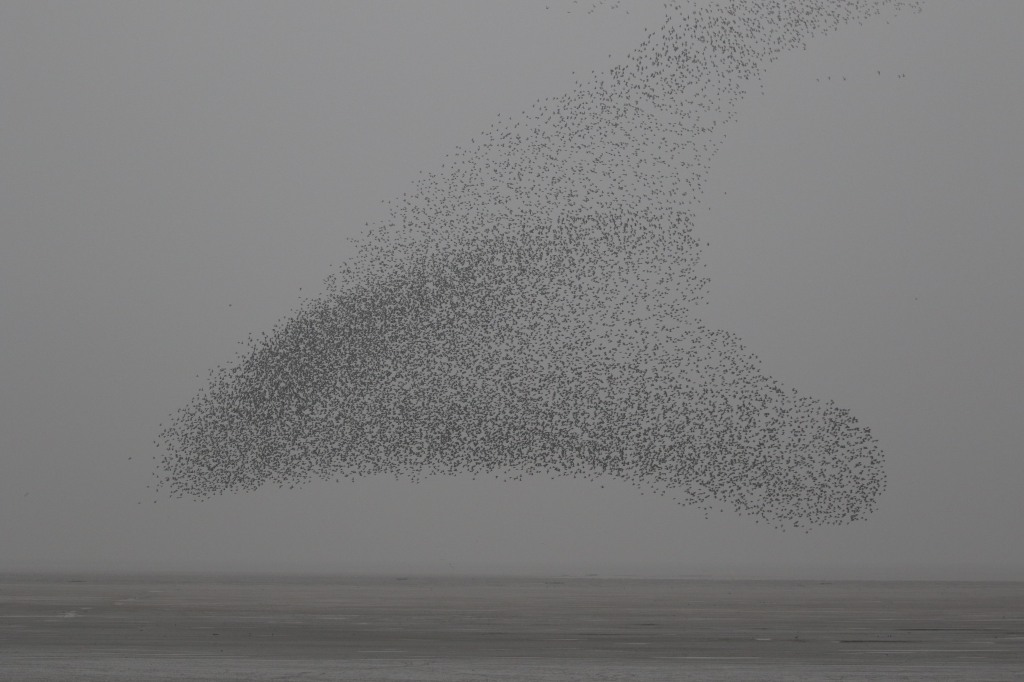
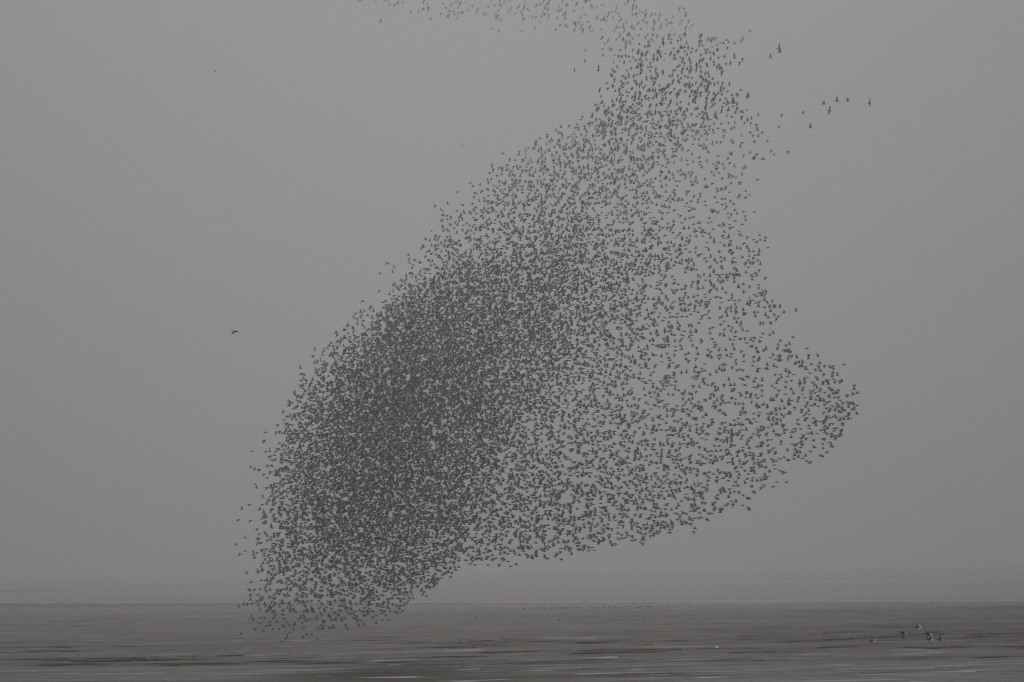
A Spoonbill circled low over the channel in front of us, before landing down on the mud. It started to feed in some of the shallow pools just across the channel, sweeping its bill back and forth as it walked. Pretty quickly, the tide filled the pools and the Spoonbill found itself mid-channel. It flew off up over the Pit.
We could hear Pink-footed Geese out in the mist and saw a small flock fly round and land again on the mud. More flew in from inland, flying over our heads calling and joined them out on the Wash.
Once they landed again, a lot of the Knot were gathered on the shore just across the channel from us. They were very well camouflaged against the grey of the mud, but with the naked eye you could make out a vast slick slightly darker then the background. The Oystercatchers had already gathered higher up on the mud, away to our left, and the black being more contrasting had formed another, more obvious slick over there.
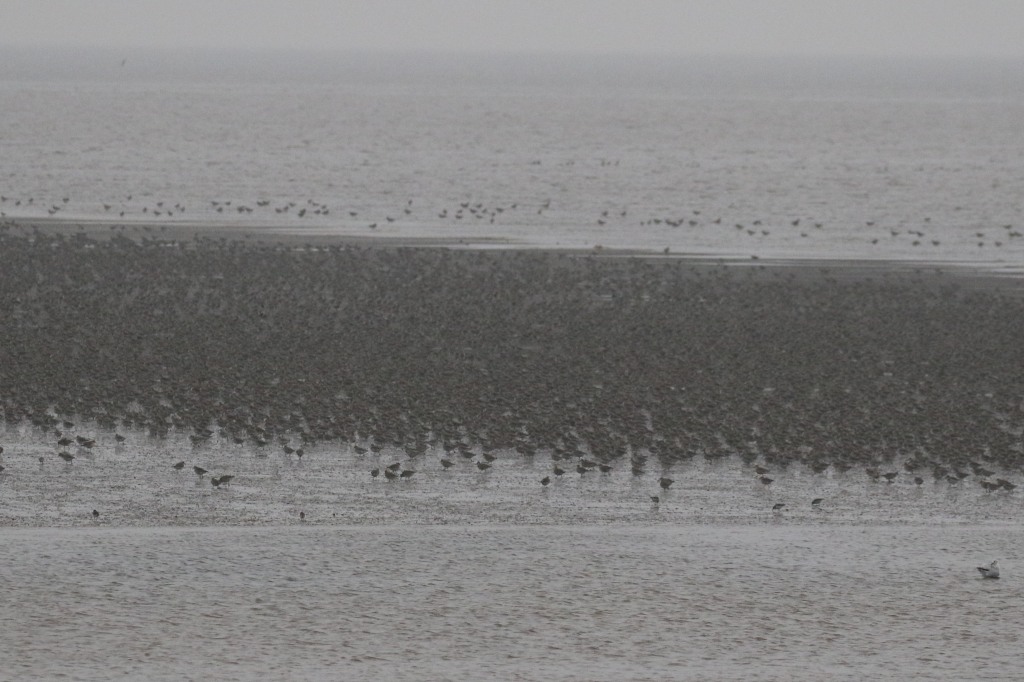
There were lots of other waders scattered more widely over the mud in front of the Knot. We scanned through them, lots of Dunlin, Ringed Plover, one or two silvery-white Sanderling, Grey Plovers and Bar-tailed Godwits. A Spotted Redshank dropped in briefly in the channel, giving us just enough time to get the scopes on it quickly before it flew past us up the channel calling.
At first, many of the Knot were flying away from the rising tide, as they usually do. We saw the ones on the water’s edge several times flying up and over those still on drier ground, landing again on the other side of them. The Oystercatchers normally walk away from the tide, but today the Knot closer to us were doing the same, the whole flock seeming to flow across the mud.
With so many people here today, we decided to walk straight on down to the south end to secure a spot from where we could look out over the mud and watch the unfolding spectacle. The Knot on the front edge left early today, didn’t wait to be squashed in to the corner, peeling off in waves and flying in past us. The Oystercatchers also started to fly in, in a succession of small groups and lines, piping noisily.
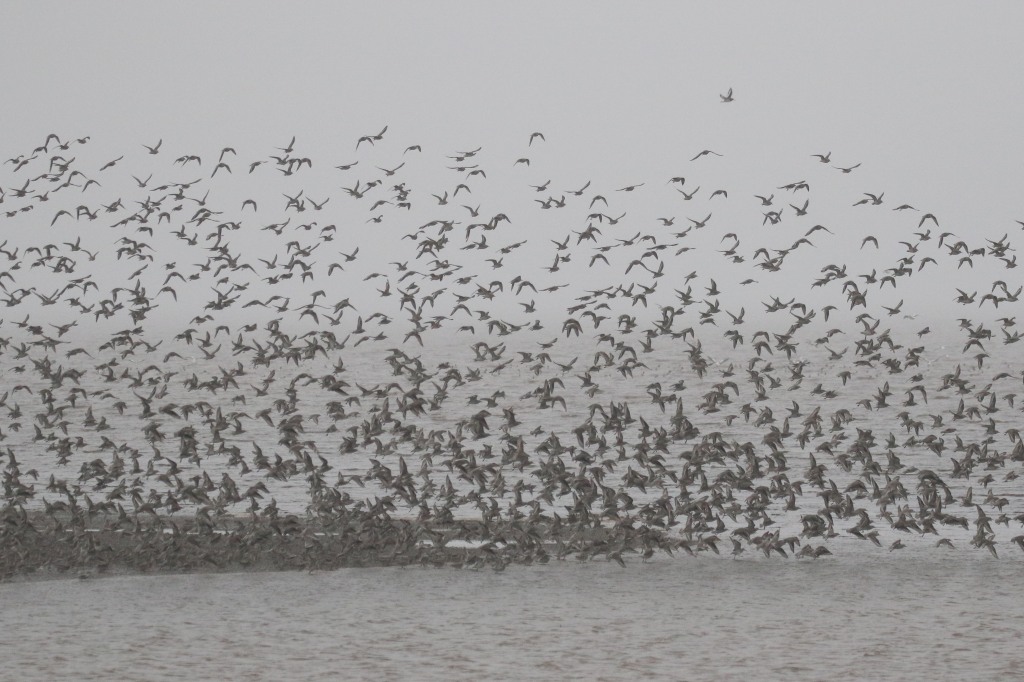
The remainder of the Knot were getting increasingly packed into the last remaining corner of mud. It had already started to drizzle, but just ahead of the climax it got harder, just at the wrong moment. Many people left and headed into the hides. We stayed out to watch and started to get rather wet!
Finally the Knot came in, taking off in a series of waves and coming in over us. We listened to thousands of pairs of wings beating overhead, and turned away from the rain to watch them swirling down onto the Pit behind.
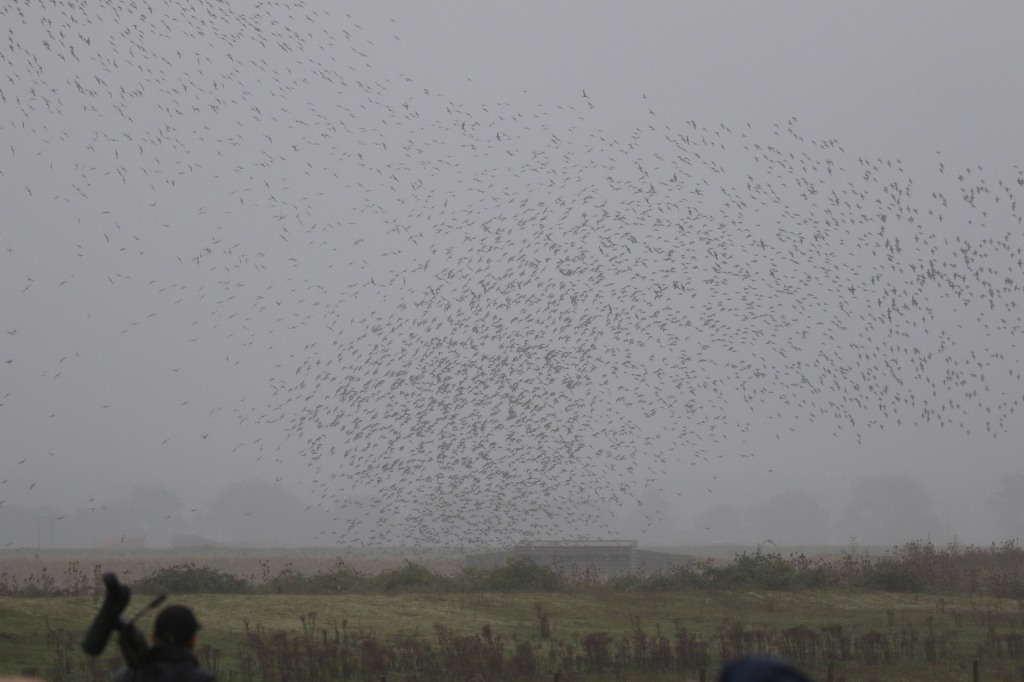
With so many people here today, the hides were full and we could see people outside on the banks. Some had even climbed over the fences to be able to find somewhere they could view the Pit. Once most of the Knot were in and there were only a few waders left out on the Wash, we decided we needed to seek shelter, so we walked back up to Rotary Hide, the unfashionable hide, just to get out of rain. We could see the Knot gathered on some of the islands to the south. There were a few ducks out on the water this end, mainly Wigeon, plus a couple of Shoveler.
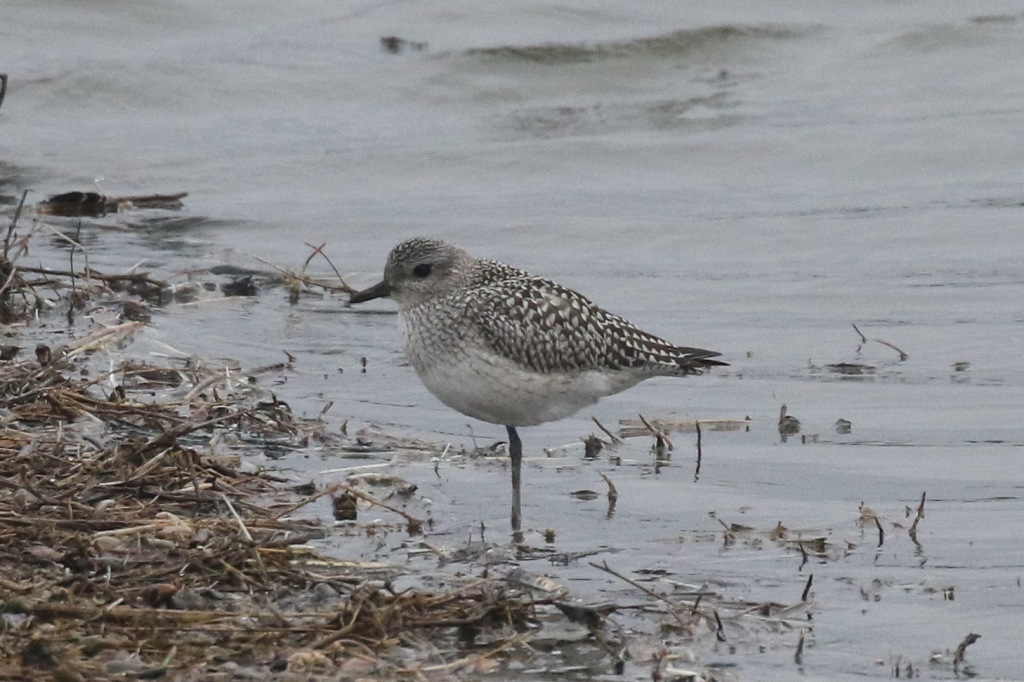
We watched lots of people leaving early, trooping past the front of the hide, heads down in the rain. So when it stopped raining, we decided to walk back down and try our luck in the other hides. We managed to get straight in to Shore Hide now. The island in front of the hide was typically mostly empty, but a smart Grey Plover was on there today, along with a couple of Dunlin and Ringed Plover.
Three Spotted Redshanks were roosting on the rocks in the middle of the Pit with the Cormorants, in their usual spot. A little group of Common Redshanks flew in to join them and the Spotted Redshanks woke up, showing their longer, needle fine bills.
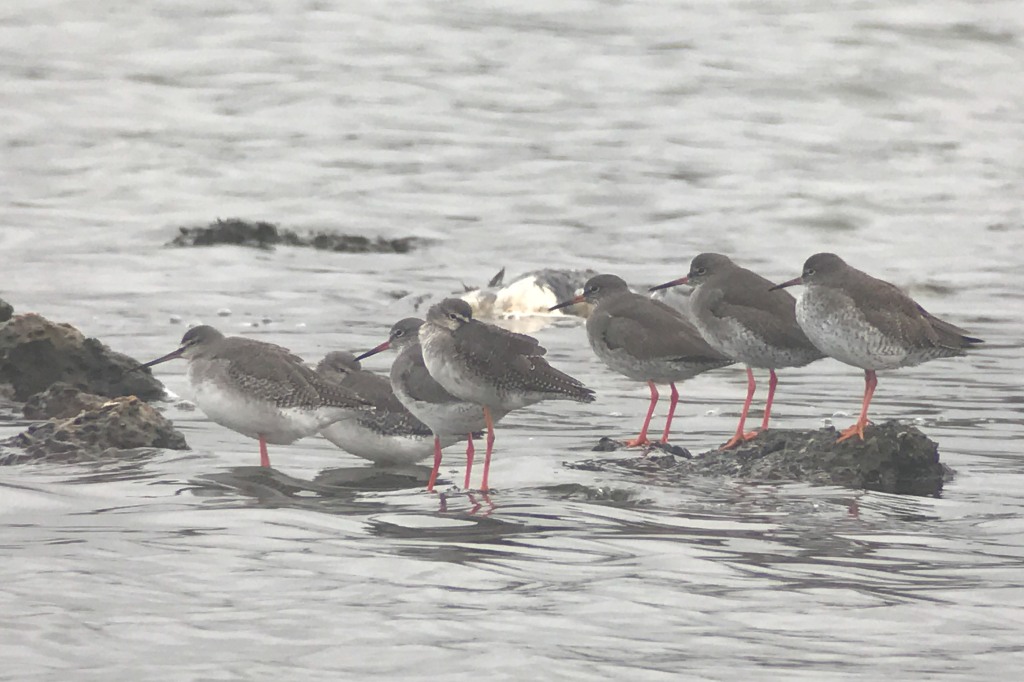
As more people left, we managed to get up to the end of the hide to scan the island just to the north. There were not many Knot on there today so the island was mostly empty, but there were still a good number of Dunlin. Scanning through carefully, we found a single Little Stint in with them. Then all the waders spooked and took off, and although a lot of the Dunlin landed again the Little Stint didn’t come back in.
Most of Knot were roosting down at the south end today, on the shingle bank on the side of the Pit. As we walked on round to South Hide, a line of Knot came out of the Pit and flew out over the Wash, but they were too early still and before we had even got round to the hide they came back and dropped back in to the roost.
We managed to get straight in to South Hide too now. It was well worth it – an amazing sight, a grey carpet of Knot packed in tight on the shingle bank in front, shoulder to shoulder, so you could almost struggle to tell they were even birds. There were Oystercatchers above them, higher up the slope, one or two Dunlin around the edges and a Turnstone feeding on the vegetation in front. But it was mostly an amazing mass of Knot.
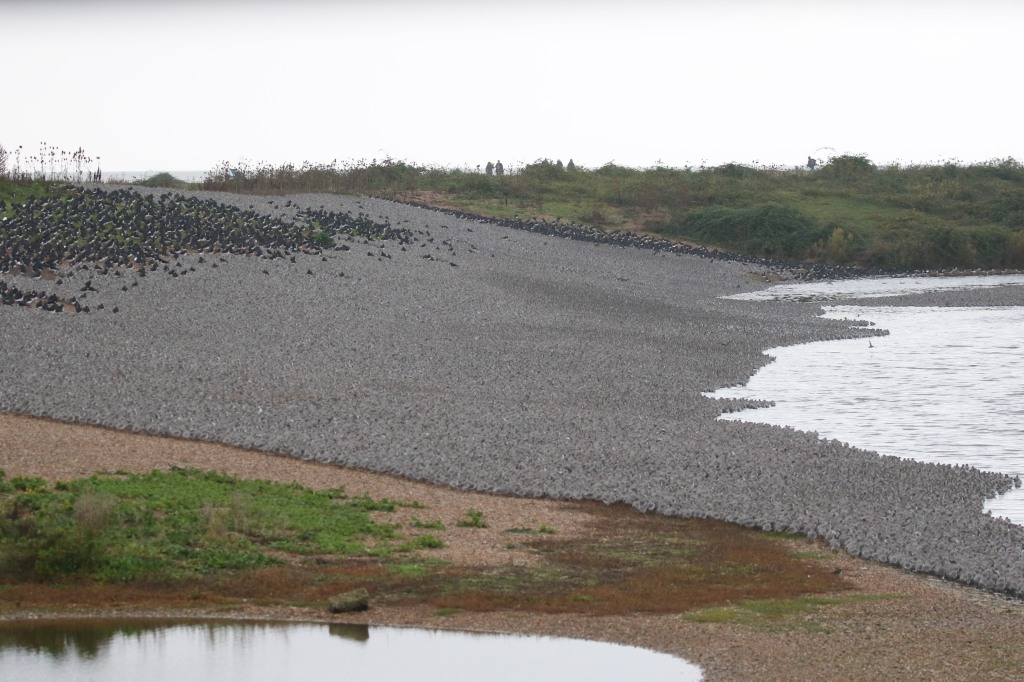
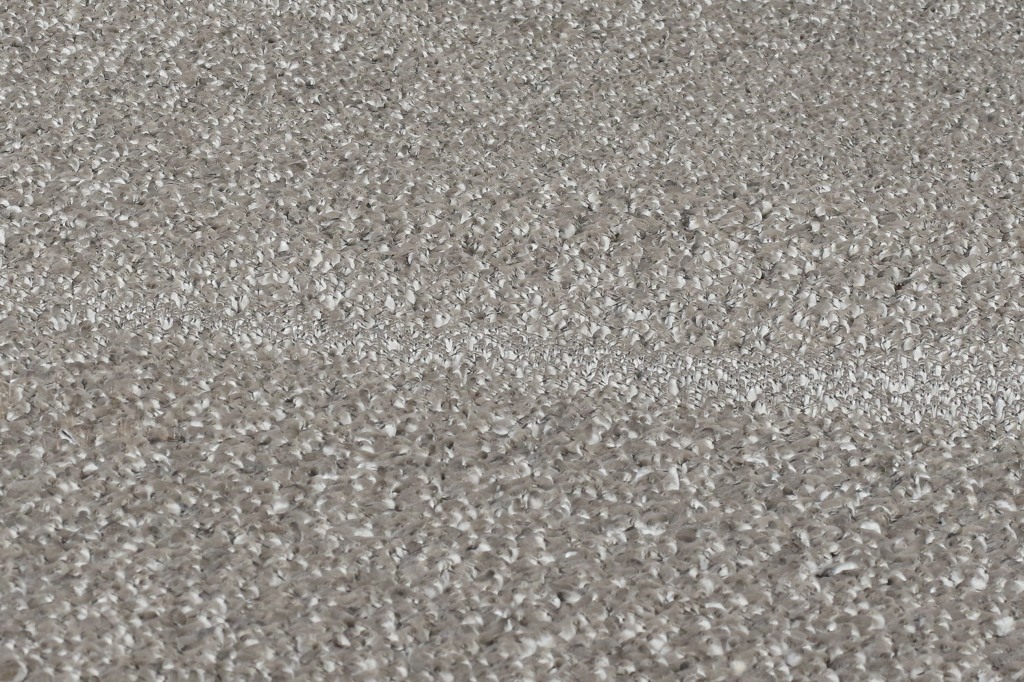
The sun had come out now, and caught the Knot as they turned, alternately flashing grey and white. They were constantly shuffling, birds at one end of the flock getting pushed, setting off waves which ran through the flock. Birds at the bottom edge getting pushed into the water and swimming across to join other know on the island. A single Oystercatcher flew in and landed in the middle of the Knot, but quickly realised its mistake.
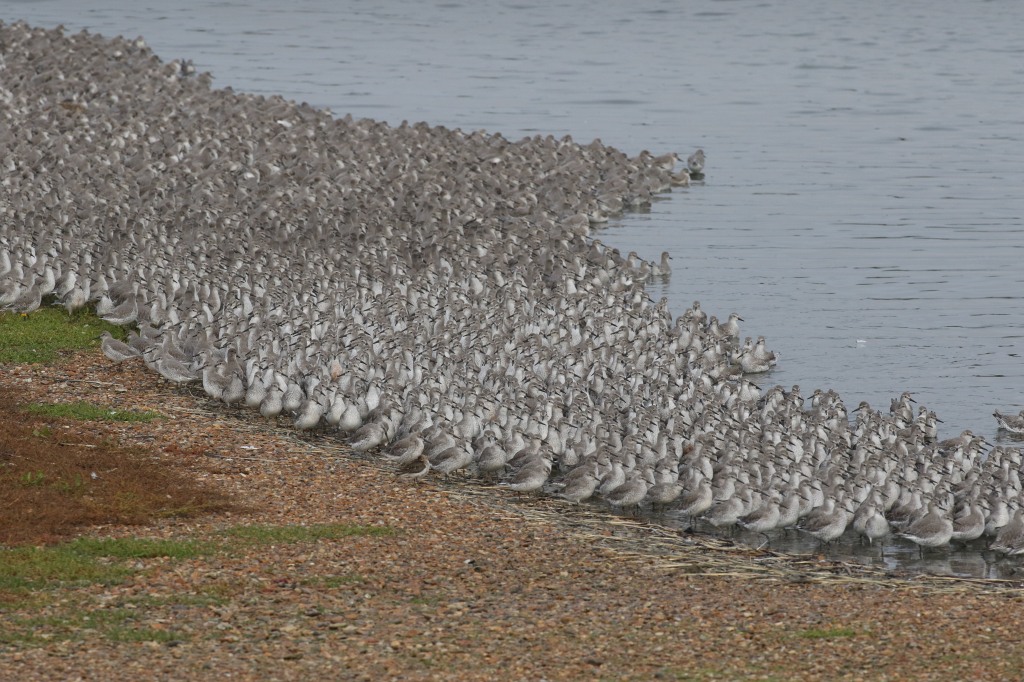
About half an hour after high tide, we decided to head back out to the edge of the Wash. We were still walking out as the first wave of Knot came out in a long line. A whole succession of small groups came out, and we positioned ourselves underneath the flight line, although this kept shifting, as the birds were always moving just away from the people standing on the bank.
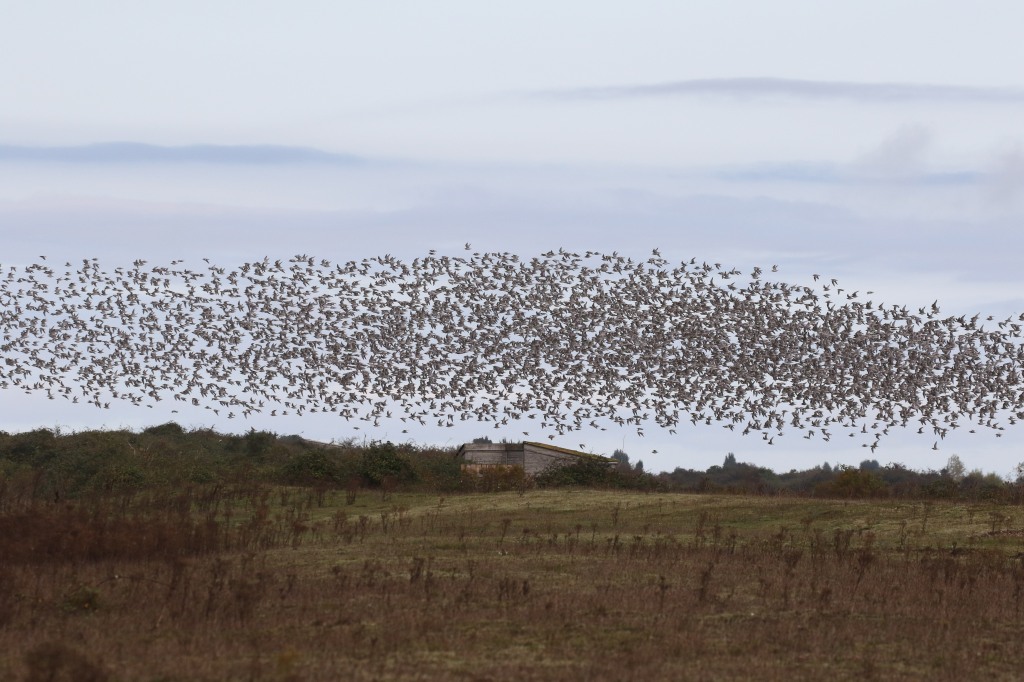
There were already quite a lot of Knot out on the Wash and they started to spread out as more and more mud became exposed by the falling tide, the birds flying up and settling again further down. Then something spooked them and they started to twist and turn, flashing in the sunshine.
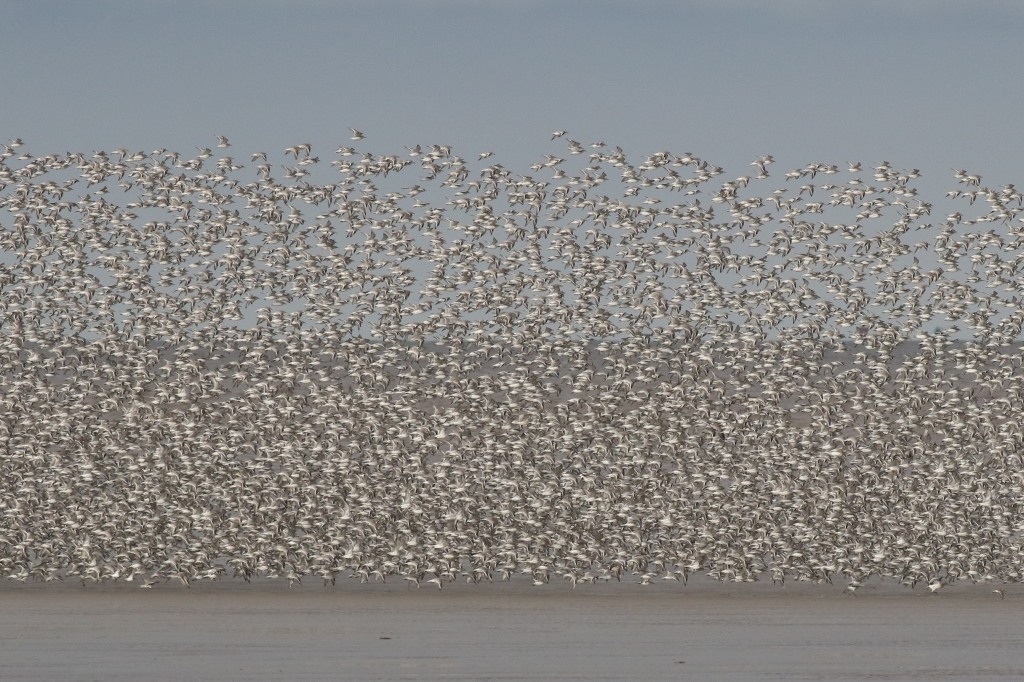
We were just watching the unfolding spectacle out in front of us, when we heard a loud ‘whoosh’ behind us and turned to see a huge mass of Knot erupt from the bank of the Pit. We didn’t know which way to look – some continued to watch the birds twisting and turning in the sunshine over the Wash, other turned and marvelled as the huge wave of birds came out right over our heads from the Pit. Stunning either way!
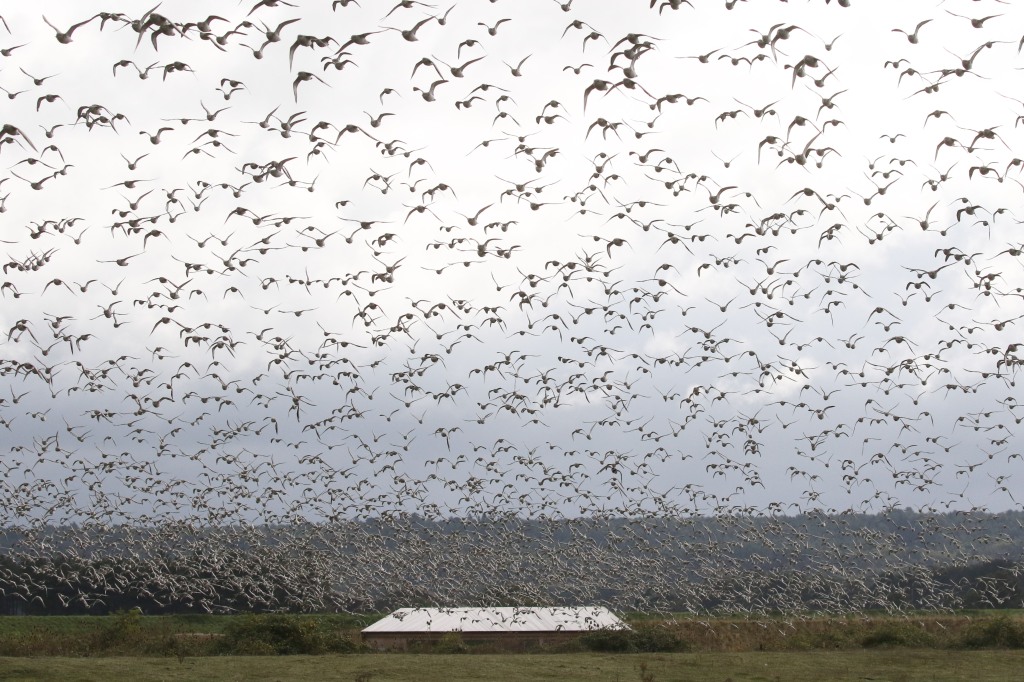
The weather was much nicer now, and it was very pleasant standing and watching the birds on the Wash. As the tide receded, the birds gradually spread out across the mud. A juvenile Common Tern flew past along the shore, and a Sandwich Tern flew out over Wash. We picked up a couple of Gannets distantly out over the water too.
There were lots of Shelduck on the water and a large flock of Pintail flew in and landed in with them. Some of the drake Pintail are just starting to get a little ghosting of their breeding plumage again now. A Guillemot was bobbing on the water behind.
There were a few raptors out over the saltmarsh beyond this morning – a couple of Marsh Harriers, a Common Buzzard and a Kestrel – but we couldn’t find any of the Peregrines today. The Knot occasionally took off, turning in the sun, before landing further out on the mud each time. The tide was well out now.
We walked back to the minibus and headed round to Titchwell for an early lunch. We only had a couple of hours, as we planned to finish a little early today after the very early start, so we headed out onto the reserve.
The reedbed was quiet and there was nothing on the pool again today. We stopped by Island Hide, and there were couple of Bearded Tits in the reeds again, coming up to the tops occasionally just below us.
Scanning the freshmarsh from the bank by the new bund, we admired the huge flock of Golden Plover and some nice Lapwings which looked stunning in the sunshine. There were more Avocet here today – a group of nine roosting together on one of the island and several more scattered round feeding, at least 14 in total. Otherwise, there was a scattering of Dunlin and a few Ruff. There were Curlews out on the saltmarsh behind and a Common Snipe flew round.
According to the volunteers we met, there had been a couple of Spotted Redshank from Parrinder Hide, so we popped in for a quick look. We couldn’t find any sign of them now. Scanning the back of the Freshmarsh from the terrace higher up, there were lots of Black-tailed Godwits. A Rock Pipit was feeding along the edge of the new bank.
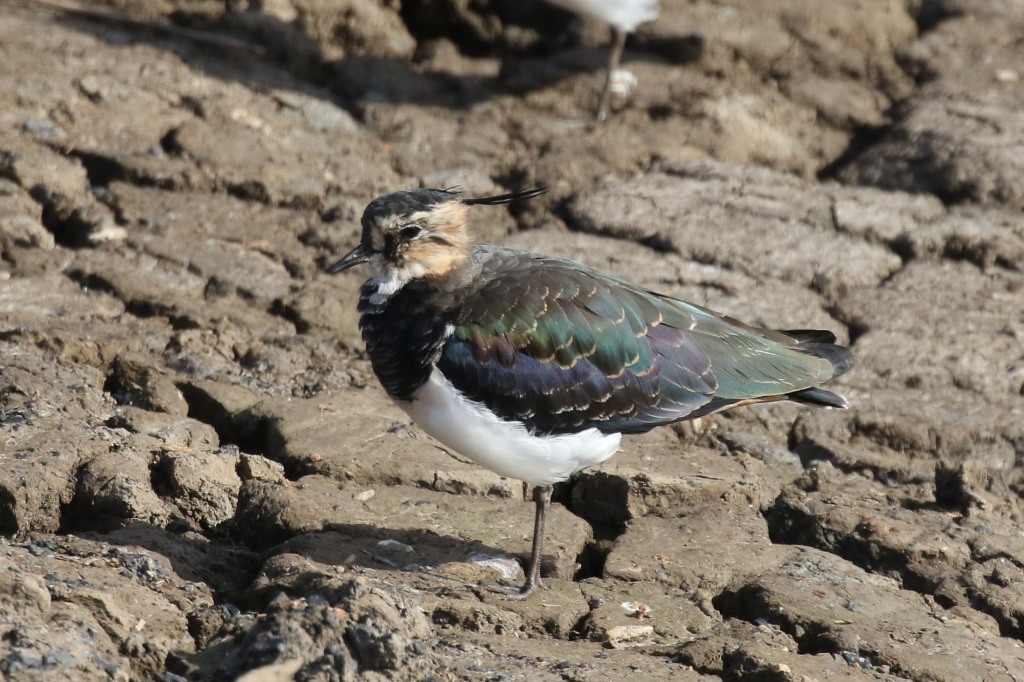
We wanted to have a quick look out at the sea. There had been some of the scarcer grebes here in the last couple of days, but according to the volunteers there had been no sign so far today. Scanning from the top of the beach, we could just see Great Crested Grebes too. There were quite a few auks again, Razorbills and Guillemots, though they were further out today. A Red-throated Diver flew west along the shore, then turned in and flew round over the mussel beds, before heading off down the beach towards Brancaster.
There was a report of a Cattle Egret on Patsy’s Reedbed this afternoon, so we thought we could swing by on the way back. It turned out we didn’t need to, and it had saved us the walk. As we got to the Freshmarsh, we noticed it standing on the new bank across the middle in with the Black-headed Gulls. We got it in the scopes and had a good look. A nice bird to add to the list and a good way to end the trip.
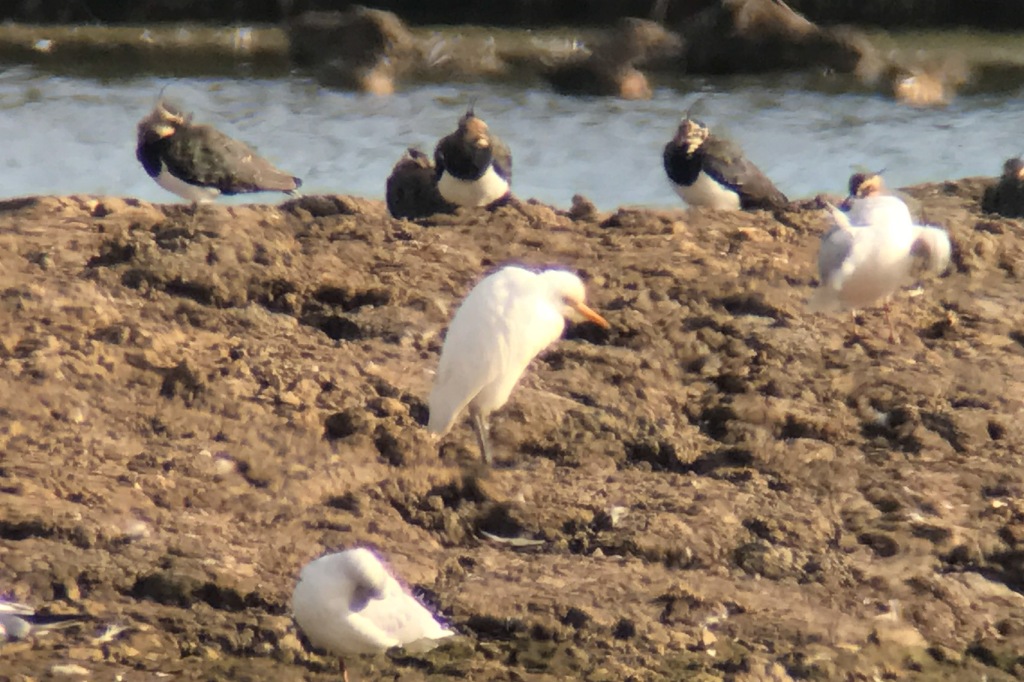
Unfortunately it was time to head back now. As we walked back into the trees, a couple of Siskins flew over calling, and landed in the alders on the edge of Thornham Grazing Marsh. Then we headed back to the car park. It had been a very enjoyable four days of Autumn birding in Norfolk – not awash with migrants this year, the weather had not been right, had been a little too good most of the time – but we had still managed to dig out some very good birds anyway.
















